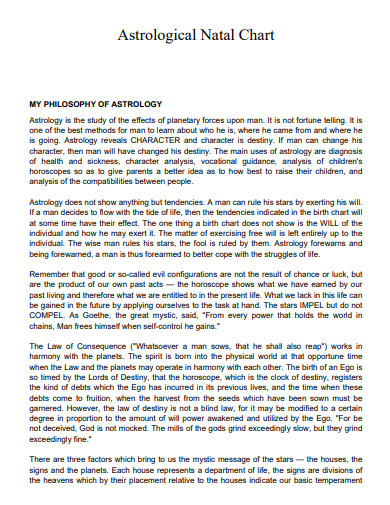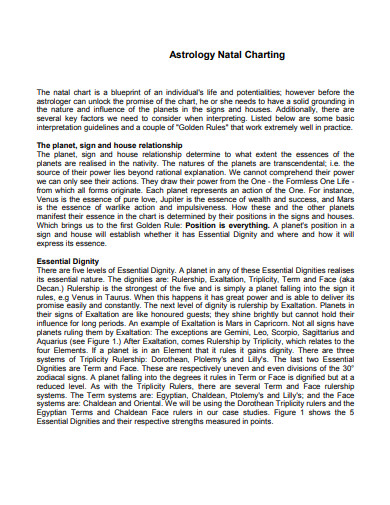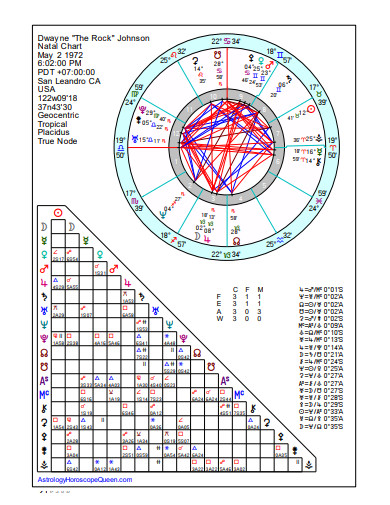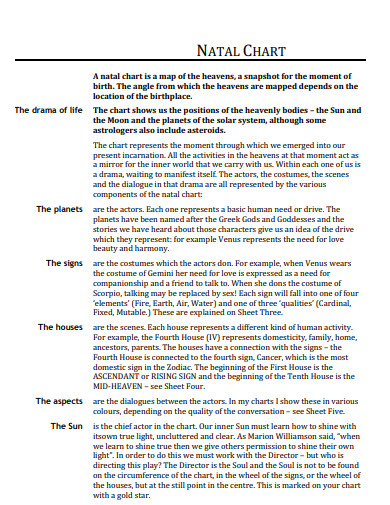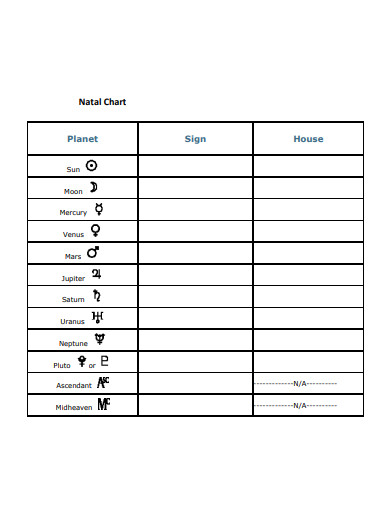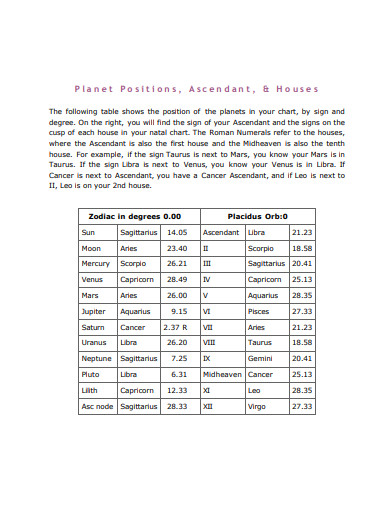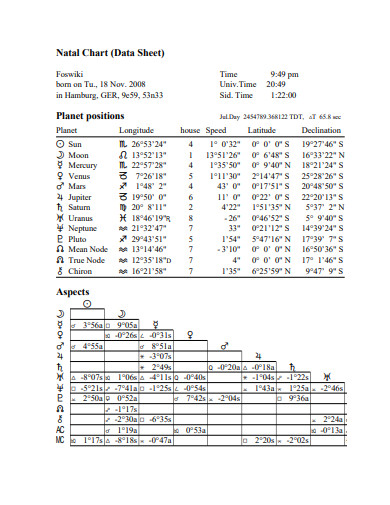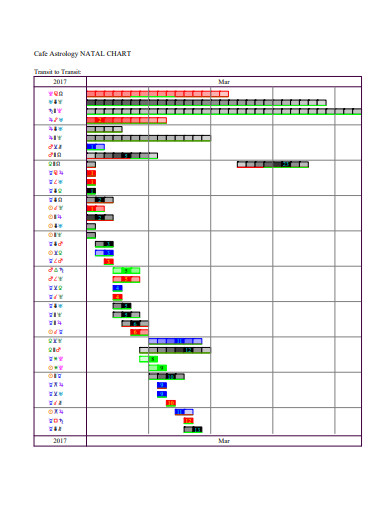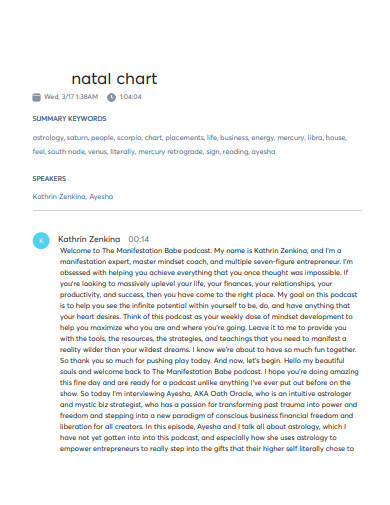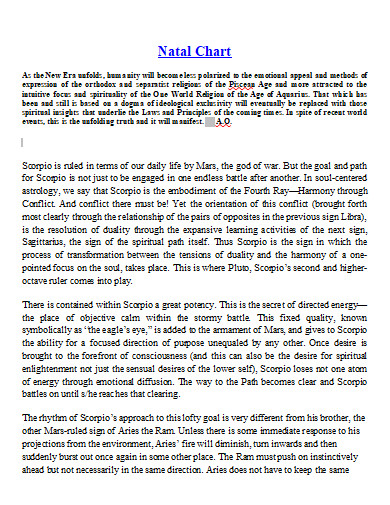Planetary placements, or where a planet was when you were born based on your geographical location, are included in natal charts. The planets are represented by glyphs on natal charts, and while there are other variants of these glyphs, the one seen here is the most common. These planets and their positions are significant because they reflect various facets of your personality. So when an astrologer says things like “your Venus is in Gemini” or “your Venus sign is Gemini,” they’re referring to the fact that a particular star sign (in this case, Gemini) influences whatever personality attribute the planet (Venus) is associated with.
10+ Natal Chart Samples
An astrological birth chart, also known as an astrology natal chart, is a depiction showing where all the planets were in their orbit around the Sun at the time you were born (from our vantage point on Earth). An astrology chart reading can disclose your strengths and shortcomings, as well as your spiritual growth prospects and the optimal time to make major decisions. You’ll need your time, date, and place of birth to generate your astrology birth chart. Some folks have no idea when they were born. If you can’t locate it on your birth certificate, contact your state’s or region’s Vital Records office. If it doesn’t work, try an educated guess or type 12:00 noon.
1. Astrological Natal Chart
2. Sample Astrological Natal Chart
3. Natal Chart Report
4. Sample Natal Chart
5. Simple Natal Chart
6. Basic Natal Chart
7. Formal Natal Chart Report
8. Natal Chart Format
9. Cafe Astrology Natal Chart
10. Professional Natal Chart
11. Printable Natal Chart
Natal Chart Explained
Understanding how to read a natal chart requires being able to distinguish the planets in your conversation, as illustrated using the symbols below, and analyzing what their placement implies. Below, you’ll find that information organized by planet.
- Sun – A circle with a dot in the middle is the glyph. The sun is a star, and it’s the one that’s most related with your horoscope, which is why it’s called your star sign. It reflects your most outspoken nature and straightforward self.
- Moon – A crescent moon is the symbol for this glyph. Your moon sign is a mirror of your emotional character and inner self that others can not see. The moon communicates with your emotions and who you are at your core. This quality is generally good for business, and not so much for life—Virgo moons must remember to take care of themselves.
- Rising – An upward-pointing arrow is a glyph. This isn’t a planet, and you’re not misremembering sixth-grade science. However, it is still necessary background for reading a natal chart, therefore it is provided for reference. The outer picture you display to the world is your ascendant or rising sign.
- Mercury – Glyph: A circle with two “horns” at the top and a cross at the bottom. Mercury is frequently associated with Mercury retrograde distinct horrors, but this planet isn’t all awful. Mercury is the planet that governs intelligence, communication, travel, and technology, according to astrology.
- Venus – Glyph: A feminine symbol is a circle with a cross underneath. Because Venus is the goddess of love and beauty, your Venus sign is essentially your celestial love language—the way you reciprocate affection.
- Mars – Glyph: A circle with a diagonally pointed arrow (a male sign). Mars is associated with a fiery, red-hot, strong, assertive energy, and your Mars sign is primarily concerned with aggressive, action-oriented physical activities—basically, anything that gets your blood flowing. It serves as a showcase for your sex life and can assist you in determining which workout is best for you.
- Jupiter – Glyph: A four-pointed star with a curving arm. Jupiter is the planet of luck, good fortune, truth, and how we wish to grow and expand, and it has a very hopeful spirit. According to the position of Jupiter in my horoscope, I’ll be able to advance in publishing and have a lot of luck raising my voice across multiple platforms.
- Saturn – A curly “h” with a cross on top is the glyph. Saturn is commonly associated with Saturn return, which occurs every 28 to 30 years and gets a bad rap, according to Caponi. Saturn signifies obstacles, responsibilities, rules, and everything that screams, “YOU’RE AN ADULT NOW!”
- Uranus – Glyph: Three vertical lines, one with a bulbed end on the center line and the other with a horizontal line running through the center. Uranus is the ruler of Aquarius, which is all about originality, and it speaks to what makes you original and unique in your horoscope.
- Neptune – A trident is the glyph. Neptune, like Uranus, spends 14 years in each sign, so it affects a group of people rather than unique special snowflakes. Neptune is a creative force, which makes sense given how artistic water signs are, and he rules over dreams and imagination.
- Pluto – Glyph: A wine glass with a central circle. Pluto, despite its little size, has a colossal transit: it takes Pluto 30 years to migrate to the next sign, which means it spans more than a generation.
FAQs
What are solar return charts?
The solar return chart, also known as your “birthday chart,” is a one-year chart that spans your current birthday to the next. The charts will differ based on where you are. For the best results, time your festivities to coincide with the stars!
How long have astrology charts like these been around?
Western astrology, which has been practiced for thousands of years. Since the birth of civilization, humans have been tracking the movement of the heavens. As far back as 6000 B.C., there was a time when The Sumerians kept track of the movements of the planets and stars. Around the year 3300 B.C. Over thousands of years, the Babylonians (also known as the Chaldeans) built on the Sumerian foundation, producing the first astrological system. Around 700 B.C., they constructed the zodiac wheel that we use today (with planets and houses). The oldest known horoscope chart is thought to have been created around 409 B.C.
If you want to see more samples and formats, check out some natal chart samples and templates provided in the article for your reference.
Related Posts
FREE 10+ Seat Chart Samples in PDF
FREE 10+ Pie Chart Samples in PDF
Free 3+ Eye Color Chart Samples in PDF
FREE 10+ Family Chore Chart Samples in PDF
FREE 10+ Classroom Chart Samples in PDF
FREE 10+ Genealogy Chart Samples in PDF
FREE 10+ Shipping Chart Samples in PDF
FREE 10+ Goal Chart Samples in PDF
FREE 10+ Character Chart Samples in PDF
FREE 10+ Table Seating Chart Samples in PDF
FREE 10+ Classroom Seating Chart Samples in PDF
FREE 10+ Grade Chart Samples in PDF
FREE 10+ Workflow Chart Samples in PDF
FREE 10+ Budget Chart Samples in PDF
FREE 10+ Process Flow Chart Samples in PDF

